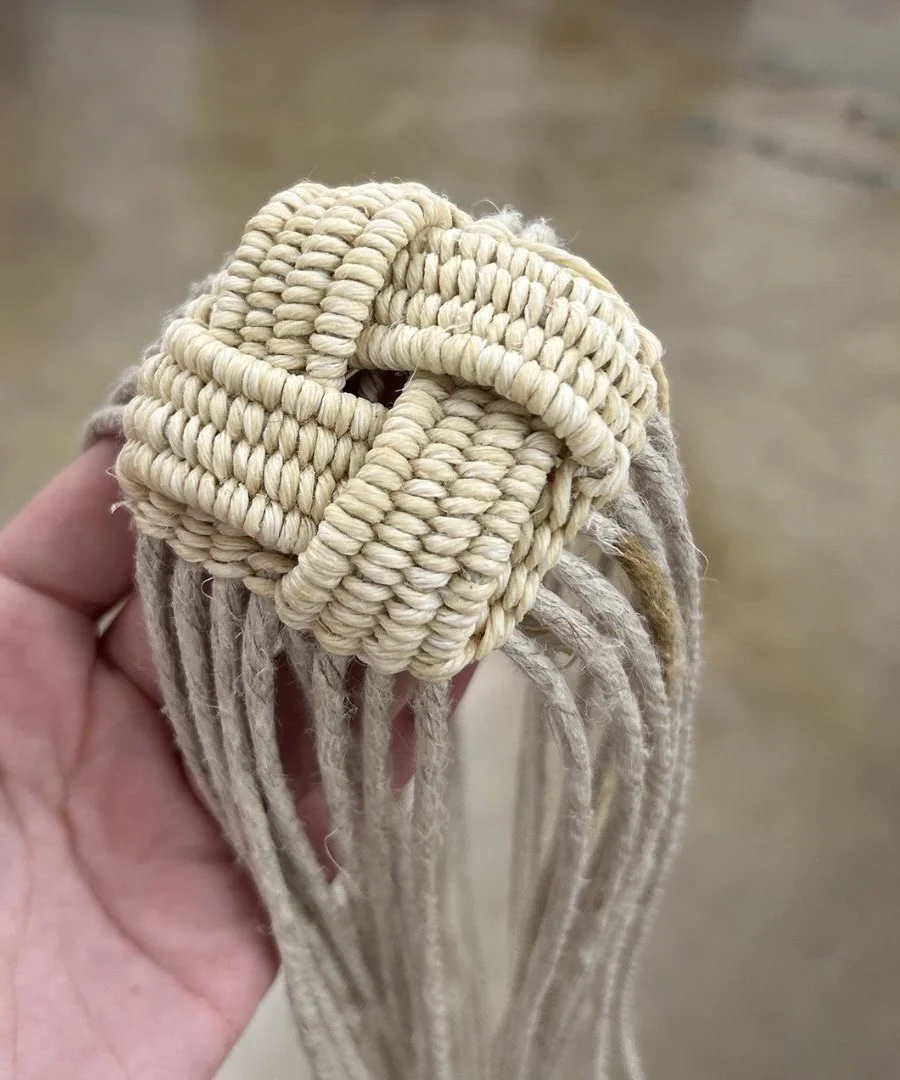Interview: Jolene Dosa
Jolene Dosa is an artist and grade school teacher based in New York. Through her art, she partakes in a playful process of connecting and bonding contrasting materials, paying close attention to the areas where heavy and lightweight material meet. Basketry, plaiting and weaving techniques are essential to this process. In 2017 Jolene completed a BFA from the Rhode Island School of Design and has shown work throughout the United States.
Read our interview with Jolene below!
June, Found yarns and steel woven on floor loom, 5 x 6 feet, 2020
PP: Walk us through a typical day in your studio or generally through your process to make new work.
JD: Like many New Yorkers, my studio is my apartment. New work is born out of falling in love with a new material or process. Currently, that love is twining waxed linen to create both useful vessels and sculptural forms. Twining feels familiar because I have done a lot of floor-loom weaving and am comfortable with the slow process. I think a lot about the muscle groups I use while making, and the connection between that part of my body and the art object that is produced.
Muscle Memory, Liquid porcelain on steel plates, 12 x 12 inches, 2024
95 on 81, Found yarns and steel woven on floor loom, 12 x 18 inches, 2023
PP: What motivates you to make art?
JD: It’s really a physical instinct. I like to touch materials and use my hands to think through ideas. Drawing and painting is a more psychological, concept-based process for me which involves a lot of searching and yearning for the outcome to take shape. Weaving, basketry and other processes I am starting to learn such as metalsmithing are more playful and direct. For me, craft is like escapsim.
PP: What is your favorite medium and why?
JD: My eternally favorite medium is weaving baskets with round reed. I had the opportunity to learn this skill in 2019 and fell in love. I love the necessity of water in the process, the chemical reactions happening in wet and dry reed, and the subtle sculpting that happens as a vessel is grown. I also love hearing basket weavers talk about their craft and thinking about the history and primal relevance of these forms.
WIP: beginning of a woven waxed linen vessel
PP: What challenges have you faced as an artist and how do you overcome them?
JD: Balancing my day job, which is my livelihood, with the constant desire to be making. I am fortunate as a teacher to have work breaks throughout the year which help me plan out when and how I can have full studio time. I am learning to pace myself during the school year and maintain stamina to make my own art after hours.
PP: What is your process like for critiquing your own work?
JD: Whether a project is in progress or done, I use my phone to take a lot of photos and videos of it. When I am at work, commuting, out in the world, I take time to look at the photos and try to see them objectively. The reality is a lot of artwork is perceived only online these days, so I try to consider a piece from a purely digital standpoint. I then can return to the physical piece and make tangible adjustments. It’s also helpful to share photos in progress with certain friends or family members. It takes a lot of time and consideration before I share my work.
PP: What challenges have you faced as an artist and how do you overcome them?
JD: Balancing my day job, which is my livelihood, with the constant desire to be making. I am fortunate as a teacher to have work breaks throughout the year which help me plan out when and how I can have full studio time. I am learning to pace myself during the school year and maintain stamina to make my own art after hours.
PP: What is your process like for critiquing your own work?
JD: Whether a project is in progress or done, I use my phone to take a lot of photos and videos of it. When I am at work, commuting, out in the world, I take time to look at the photos and try to see them objectively. The reality is a lot of artwork is perceived only online these days, so I try to consider a piece from a purely digital standpoint. I then can return to the physical piece and make tangible adjustments. It’s also helpful to share photos in progress with certain friends or family members. It takes a lot of time and consideration before I share my work.
To learn more about Jolene’s work, see her Instagram and Website




